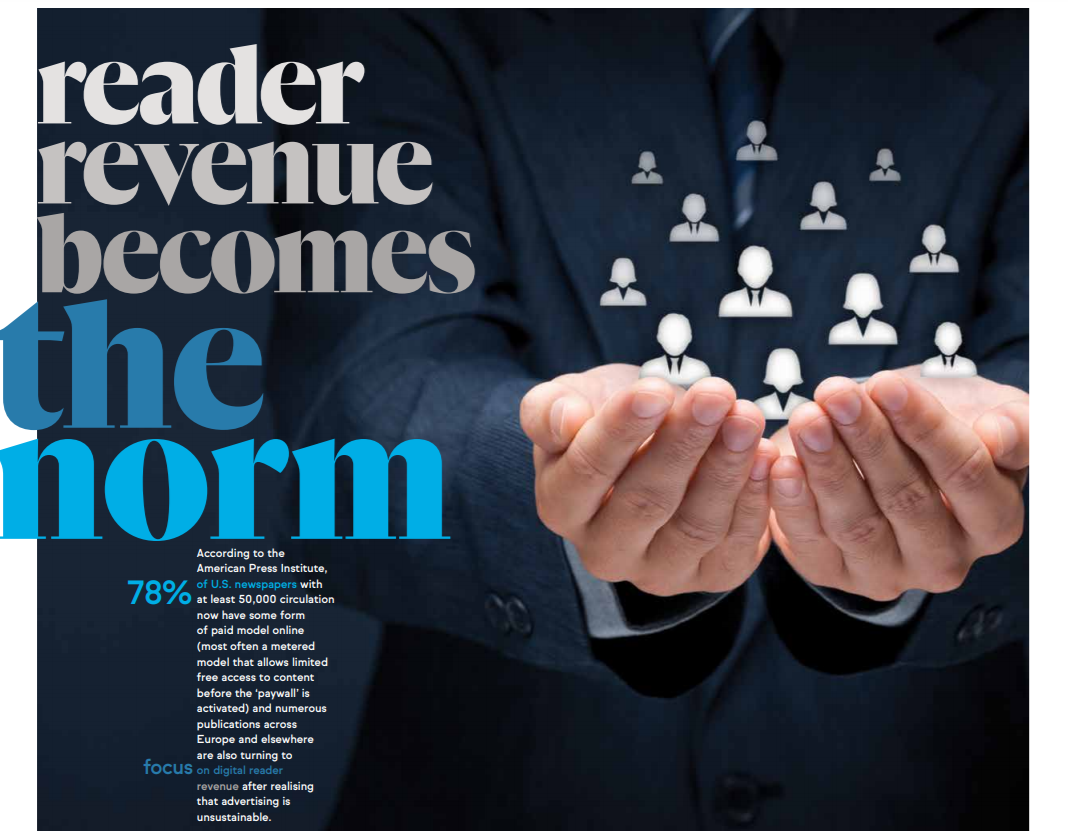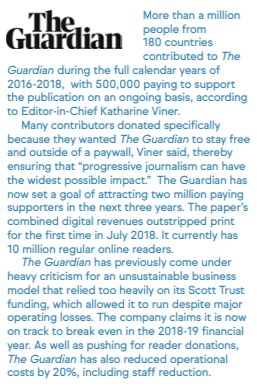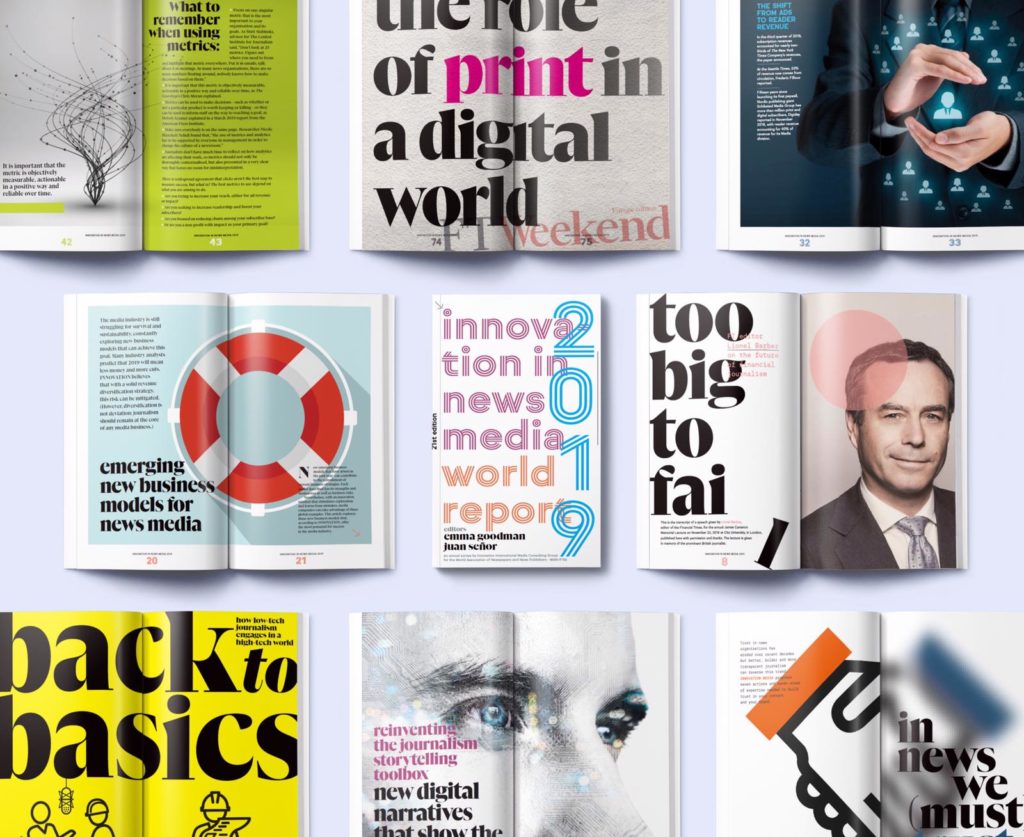
04 Mar READER REVENUE BECOMES THE NORM
As we stressed in last year’s report, there is no point in thinking about how to charge for your digital product unless you are confident that you can offer both content and an experience that readers will find worth paying for. You must have something unique to offer, that is a pleasure to read, or watch or listen to.
Aiming High
Among participants at an Axel Springer summit on paid online content in early 2019, more than half were aiming to make subscriptions their largest digital source of income during this year. 79% of those responding to the survey believed that the public in their country were becoming more willing to pay for digital content.
This is positive, but the Digital News Report survey published by Reuters Institute for the Study of Journalism in summer 2018 found significant disparities between countries in terms of how many people were paying for online content. Nordic countries are making the most progress, with 30% of those surveyed in Norway paying for online news in the past year (+4% compared to the previous year.) A reported 26% of respondents paid for news in Sweden (+6%), and 18% in Finland (+4%.) However, the rate drops to 7% in the U.K., 8% in Germany and 9% in Canada.
The U.S. ‘Trump Bump’ seems to have been maintained, with 16% of Americans paying for online news, compared to 9% in 2016. The increase has mainly benefitted liberal-leaning newspapers like The New York Times and The Washington Post. Out of respondents identifying as left-leaning, 29% have paid for online news, compared to 8% of those identifying as right-leaning.

Reducing churn, focusing on engagement
We are seeing an increased focus among publishers on reducing churn – meaning subscribers who do not renew – rather than on attracting new subscribers. This reflects the ways that paid content market is maturing, as publishers’ confidence in their subscriber acquisition strategies continues to grow. According to the Axel Springer survey on paid content strategies in early 2019, ‘churn prevention’ was ranked second on the list of priorities for the success of paid content, whereas it was ranked fourth the previous year.

The key word that comes up here again and again is engagement.This is seen in both the 2018 WAN-IFRA report by Cecilia Campbell, ‘Engaged Readers Don’t Churn,’ and in the recent assertion from Financial Times’ CEO John Ridding that, “A lot of attention is on retention; that is why engagement is crucial.” FT now spends three times more on engagement than acquisition. This means a shift in focus from expanding reach to engaging loyal readers.
Focusing on retention is a common sense strategy. An INMA report from late 2018 by Grzegorz Piechota found that acquiring a new customer is up to 25% more expensive than retaining an existing one. The keys to success, Piechota stresses, include to closely following audience data and remaining willing and able to react to changing subscriber behaviours. Piechota also claims that convenience is more important than content in the subscription economy, and in order to improve convenience, personalisation is crucial.
The WAN-IFRA report emphasized the importance of working across an organization to achieve customer retention, from the newsroom to customer services. As Damon Kiesow wrote for the American Press Institute, “Launching a paywall is easy. Pivoting a whole business from an advertising-centric mindset to one focused on reader revenue is not.”

Reducing churn starts from the point of acquisition. According to the same WAN-IFRA report, the method of subscriber conversion is important in predicting churn. For example, The Boston Globe has found that retention is improved when users come in through a specific process: subscribing to a newsletter. Customers who converted through special promotions, or through Facebook are likely to have higher churn rates.
A study of local news outlets from Northwestern University’s Medill School of Journalism, released in February 2019, found that frequency of local news consumption was the single biggest predictor of retaining subscribers – more than the number of stories read or the time spent reading them. Habit-forming is therefore essential.
The study also identified consumption of unique local content as a key factor in subscriber retention.
At both The New York Times and The Washington Post, the overall pattern is that subscribers who consume content across multiple sections and topics are more likely to become loyal customers, the WAN-IFRA report found. It is therefore important to surface content to subscribers that they might not otherwise encounter.
It also helps to take action to prevent churn. Canada’s Globe and Mail found that emailing subscribers with the highest propensity to churn reduced churn by 140%, while emailing subscribers who haven’t logged in for 30 days helps to reduce churn by 27%, according to Twipe. Schibsted Media has managed to retain between 10 and 15% of subscribers who start a cancellation process by sending them “positive nudges,” such as discounted offers to extend their subscription, Digiday reported.
Dynamic paywalls
The journey from engaged non-subscriber status to conversion can hit various bumps along the way, and news organisations are making use of increasingly complex data to ensure that they make the road as smooth as possible.
Propensity modelling, which predicts how likely a user is to subscribe, allows news outlets to implement ‘dynamic’ paywalls. These models utilise existing subscriber and conversion data to adapt the paywall for different users, offering different access levels, so as to offer a conversion prompt at the perfect time.
For example, Swiss daily Neue Zürcher Zeitung (NZZ) has used a dynamic ‘paygate’ to up its conversion rate by nearly five times within a year. This comes from the group’s Head of Digital Product, Rouven Leuener, during March 2019’s Newsrewired Conference in London.
Every user that visits NZZ’s site is given a score based on a variety of metrics from their usage history. Users with low levels of engagement are given 11 free articles a month, while the highly engaged (the top 20%,) are A/B tested between a set of standard and specialized rules with individual user prompts. The AI-powered paygate is constantly calculating new scores for each user.

Find what readers will pay for
The New York Times now has 4.3 million subscribers, of which 3.4 million pay for just the company’s digital products. It’s not just news that they are interested in, however. Of the 265,000 subscribers added in the last quarter of 2018, 93,000 started paying for alternative digital products like the cooking or crossword apps, rather than for the core news product.
These apps have a lower price point than the core news product, but are also likely to be significantly less expensive to produce. And unexpectedly for The New York Times, the paper found that many of the subscribers to its cooking app came from rural America, an audience that the brand has traditionally struggled to reach, Bloomberg reported in February 2019. At present, the app has more than 120,000 subscribers.
Growth in donation and crowd-funding models
According to the 2019 Digital News Report survey from the Reuters Institute, only 1% of people in the U.K. and Germany currently donate to a news organization, with a 2% donation rate in Spain and 3% in the U.S.
However, the report found that the scale of the opportunity looks to be much greater, with an average of 22% of respondents across countries reporting that they could potentially donate to a news organisation in the future, if they felt the organisation could not cover its costs in other ways.
Another encouraging finding from the Digital News Report is the fact that donations tend to come from the younger half of the population, as millennials are both more confident in paying for online services, and more enthusiastic about keeping journalism open.
Donations can be often politically motivated. Respondents talked about giving money because they wanted to identify with a cause or set of values. This presents the opportunity for a deeper relationship between readers and publications. Those who understand how the news industry works, along with the financial challenges that it faces, are much more likely to consider donating or paying for online news in the future, the Digital News Report found.

It is likely that these politically-motivated millennials are precisely who BuzzFeed News is targeting with its recent membership programme, launched in late 2018. (The ‘News’ part of BuzzFeed became its own site with its own branding in summer 2018.) It is essentially a donation strategy, offering readers the chance to pay $5/month to support BuzzFeed News, in exchange for member-only emails highlighting top stories. (And if you are U.S.-based and willing to pay $100 for a year, you also get a tote bag.)
The site is clear that it will not start charging to read content, stressing, “We were born of the open web, and reporting to the widest possible audience is in our DNA,” and that paywalls “mean only those who can afford to pay get access to quality news.” It is seen as an unusual strategy for a venture capital-funded company, but BuzzFeed says it is only one of many revenue streams being pursued.
Focus on compelling content
We would argue, as we have for some years, that pursuing digital reader revenue is essential. It is not going to be easy for every – one, however, and it is important to keep in mind that the majority of online news consumption happens on free websites; there remain many people who do not pay for digital news and likely never will.
It is also worth remembering that, as Rasmus Kleis Nielsen of the Reuters Institute wrote in his 2019 Nieman Lab prediction, “Much of the news currently published online is simply not worth paying for. Some of it is hardly worth our fleeting attention, let alone hard-earned cash.”
The crucial first step in building reader revenue online is to offer a compelling content proposition with elements of uniqueness. The next step is discovering how to get readers to pay and to keep paying. This will likely involve experimentation, a lot of data, and many different sectors of your organisation, but it mustn’t come at the expense of focussing on the distinctive journalism that your readers value.



